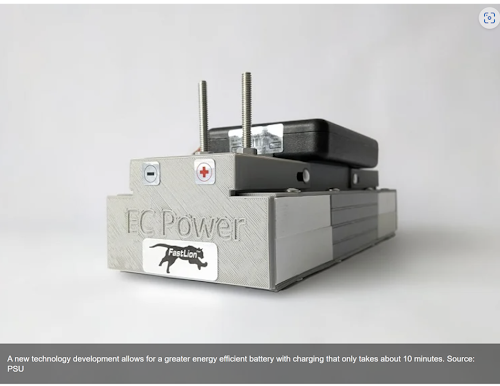December 13, 2022

By: AEOP Membership Council Member Katie Culbert
Scientists have discovered a novel way to charge an electric car’s battery up to 90 percent in just 10 minutes, opening the door for the rapid adoption of electric vehicles (EVs).
One of the biggest challenges to the adoption of EVs is charging times. Typically, a full tank in a gas-powered car will drive an average of 400 miles and only takes minutes to refuel. In contrast, a full charge for an EV will drive 200 to 300 miles, but can take upwards of 15 to 30 minutes to recharge.
Motivated by state and federal policies around environmental impact, the number of EVs on the road is on the rise, accounting for more than 5% of all new car sales in the United States. In August, California announced a ban on the sales of new gas cars by 2035 and the Biden Administration has earmarked $7.5 billion to build a nationwide charging network.
“The need for smaller, faster-charging batteries is greater than ever…there are simply not enough batteries and critical raw materials, especially those produced domestically, to meet anticipated demand,” said Chao-Yang Wang, the William E. Diefenderfer Professor of Mechanical Engineering at Penn State and lead author on the study.
About 10% of respondents to Deloitte’s 2022 Global Automotive Consumer Study cited longer charging times as their primary issue with driving a battery-powered vehicle. “Fast charging is the key to enabling widespread introduction of electric vehicles…if new car sales are going to shift to battery-powered electric vehicles, they’ll need to overcome two major drawbacks: they are too slow to recharge and too large to be efficient and affordable” Wang explained.
The authors noted, because its battery is smaller, the faster-charging batteries will also cut down on battery cost due to its limited use of critical raw materials such as cobalt, graphite and lithium, opening the door for more affordable electric cars.
How it Works
The EV battery technology uses internal thermal modulation — a method of temperature control to get the best possible performance out of the battery. Wang explains, “Batteries operate best when they are hot, but not too hot, so it is a balance of getting the right temperature in the batteries, which has been a challenge for engineers.”
The new battery structure adds an ultrathin nickel foil as the fourth component besides anode, electrolyte and cathode. Acting as a stimulus, the nickel foil self-regulates the battery’s temperature and reactivity which allows for an efficient 10-minute charge on any EV battery.
The Air Force, Department of Defense, Department of Energy, Penn State University and EC Power jointly funded the battery research.
A Five-Minute EV Charge?
A team sponsored by NASA’s Biological and Physical Sciences Division is currently working on technology that could provide another solution needed for an ultra-fast EV charging in as little as five minutes. The Flow Boiling and Condensation Experiment (FBCE) was installed on the International Space Station. The FBCE is made up of several modules; one of which is called a Flow Boiling Module (FBM). When cooling liquid inside the FBM begins to boil, the bubbles formed draw liquid from the inner part of the flow channel to its walls. According to NASA, subcooled flow boiling allows for the delivery of 4.6 times the current of the fastest available EV chargers on the market—up to 2,400 amps.
The Ford Motor Company and Purdue University engineers are also co-developing a charging cable for use with high-power charging stations that could potentially recharge an EV battery in about five minutes. The cable features a unique liquid cooling system that can phase the liquid into vapor, which improves its ability to dissipate heat. A timeline for the rollout of the new cable has not yet been announced, but a patent application has been filed.
References
- Chao-Yang Wang, Teng Liu, Xiao-Guang Yang, Shanhai Ge, Nathaniel V. Stanley, Eric S. Rountree, Yongjun Leng, Brian D. McCarthy. Fast charging of energy-dense lithium-ion batteries. Nature, 2022; DOI: 10.1038/s41586-022-05281-0. Available at: Fast charging of energy-dense lithium-ion batteries – PubMed (nih.gov)
- Penn State. “Battery tech breakthrough paves way for mass adoption of affordable electric car: Researchers develop new technique that charges EV battery in just 10 minutes.” ScienceDaily. ScienceDaily, 12 October 2022. Available at: Battery tech breakthrough paves way for mass adoption of affordable electric car: Researchers develop new technique that charges EV battery in just 10 minutes — ScienceDaily
- Five-Minute EV Charging Could Become a Reality Thanks to Hot NASA Tech (motortrend.com)
- Electric vehicles could fully recharge in under 5 minutes with new charging station cable design – Purdue University News
Find a Volunteering Opportunity
Visit our Program Volunteers page for a tool to find the best opportunity for you.
eCYBERMISSION Mini-Grant
The eCYBERMISSION Mini-Grant is intended to support teachers/program leaders as they implement eCYBERMISSION with their teams. Educators (formal and informal) of students in grades 6-9 are encouraged to apply.
